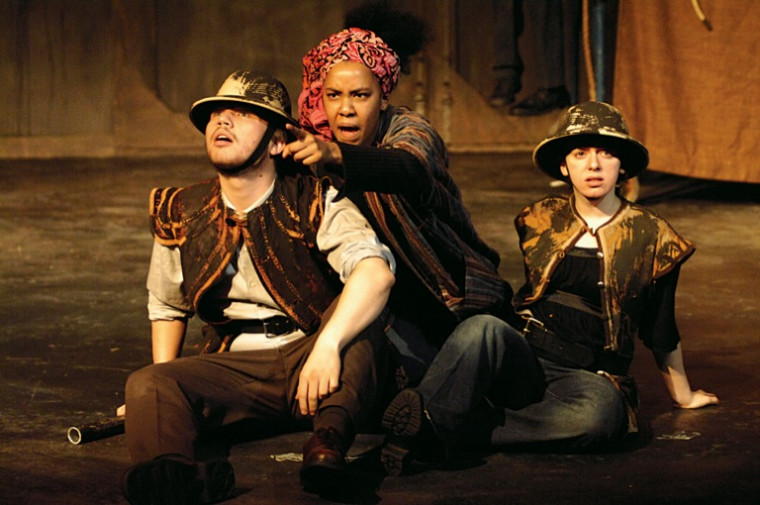Occupying Fir Acres Theatre
Open gallery

Cloth banners and tagboard signs tout slogans like “Inequality hurts us all!” and “This is what democracy looks like.” Haggard citizens huddle in a square singing Bob Dylan’s “The Times They Are A-Changin’.” If this seems more like a description of an Occupy rally than like the opening image of Bertolt Brecht’s The Caucasian Chalk Circle, then you must have missed the theatre department’s Main Stage production this fall.
The play, written in 1944 as a response to World War II, retells the ancient story of a servant in the Caucasus Mountains who, in the midst of a revolution, sacrifices everything to save the infant son of a recently toppled governor. It opens with a prologue set in 1945, in which two Soviet collective farms argue over land and propose the play as entertainment after the dispute is settled.
This fall, Stephen Weeks, associate professor of theatre and the play’s director, decided to tackle questions posed by the play (e.g., Does revolution make the world better? Can we build a more fair and just society?) in the context of last year’s uprisings in the Middle East, known as the Arab Spring. He also wanted to develop a contemporary prologue.
It was something close to kismet, then, when early in the rehearsal process, just as Weeks and his cast were attempting to devise a new prologue, the Occupy movement broke out. It was an opportunity too good to ignore.
“In a sense, the Occupy Movement is a descendent or a successor to the Arab Spring,” Weeks says, “so it wasn’t very difficult to move some of our visual materials from one to the other.”
Set designer and technical director Michael Olich, associate professor of theatre and resident designer, along with prop master and set dresser Kaye Blankenship CAS ’12, managed to represent both movements visually by building a set based on imagery from the Arab Spring, and dressing it with posters, banners, debris, and costumes that evoked the Occupy Movement.
Like most of Brecht’s plays, The Caucasian Chalk Circle tells its story partially through song, and new music is traditionally composed for each production. To meet this challenge, Weeks turned to local musician and composer Mont Chris Hubbard. Under tight time constraints, he composed 14 full songs and 22 additional pieces for underscoring and transitions (amounting to roughly 45 total minutes of music) in the course of several weeks.
As an academic production, The Caucasian Chalk Circle posed unique challenges to the student performers. Each actor did background research on the events of the Arab Spring and the individuals involved in the uprisings; wrote biographies for the characters they would be playing in the prologue and epilogue; and held improvised debates—in character—on the issues in question.
According to Weeks, these assignments were in keeping with the theatre faculty’s educational responsibility to students. “We always ask ourselves, what particular kinds of challenges are worth presenting to our students, and what challenges have we been overlooking? And in the big scheme of things, what can people see at Lewis & Clark that they can’t see elsewhere?”
—by Erica Terpening-Romeo CAS ’14
Photos by Dale Peterson and Michael Olich
More L&C Magazine Stories
Lewis & Clark Magazine is located in McAfee on the Undergraduate Campus.
MSC: 19
email magazine@lclark.edu
voice 503-768-7970
fax 503-768-7969
The L&C Magazine staff welcomes letters and emails from readers about topics covered in the magazine. Correspondence must include your name and location and may be edited.
Lewis & Clark Magazine
Lewis & Clark
615 S. Palatine Hill Road MSC 19
Portland OR 97219

